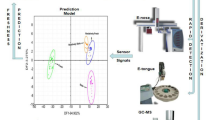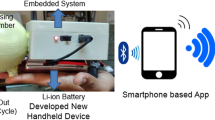Abstract
Fruits freshness is relatively easy to authenticate from their morphological characteristics while the act of processing fruits into juices makes it difficult to track/identify their freshness. Eight datasets, extracted from an e-nose and an e-tongue, and six sensor fusion approaches using both instruments, were applied to detect 100 % juices squeezed from cherry tomatoes with different post-harvest storage times (ST). Discrimination of the juices was mainly performed by canonical discriminant analysis (CDA) and library support vector machines (Lib-SVM). Tracking and prediction of physicochemical qualities (pH, soluble solids content (SSC), Vitamin C (VC), and firmness) of the fruit were performed using principle components regression (PCR). All eight datasets presented good classification results with classifiers trained by e-tongue dataset and fusion dataset 2 (stepwise selection) presented the best classification performances. Though quality regression models trained by either e-nose or e-tongue dataset were not robustness enough, sensor fusion approaches make it possible to build more robust prediction models that can correctly predict quality indices for a totally new juice sample. This study indicates the potential for tracking quality/freshness of fruit squeezed for juice consumption using the e-nose and e-tongue, and that sensor fusion approach would be better than individual utilization only if proper fusion approaches are used.




Similar content being viewed by others
References
Baldwin, E., Scott, J., Einstein, M., Malundo, T., Carr, B., Shewfelt, R., & Tandon, K. (1998). Relationship between sensory and instrumental analysis for tomato flavor. Journal of the American Society for Horticultural Science, 123(5), 906–915.
Beghi, R., Spinardi, A., Bodria, L., Mignani, I., & Guidetti, R. (2013). Apples nutraceutic properties evaluation through a visible and near-infrared portable system. Food and Bioprocess Technology, 6(9), 2547–2554.
Berna, A. Z., Lammertyn, J., Saevels, S., Natale, C. D., & Nicolaı̈, B. M. (2004). Electronic nose systems to study shelf life and cultivar effect on tomato aroma profile. Sensors and Actuators B: Chemical, 97(2), 324–333.
Beullens, K., Kirsanov, D., Irudayaraj, J., Rudnitskaya, A., Legin, A., Nicolaï, B. M., & Lammertyn, J. (2006). The electronic tongue and ATR–FTIR for rapid detection of sugars and acids in tomatoes. Sensors and Actuators B: Chemical, 116(1), 107–115.
Bleibaum, R. N., Stone, H., Tan, T., Labreche, S., Saint-Martin, E., & Isz, S. (2002). Comparison of sensory and consumer results with electronic nose and tongue sensors for apple juices. Food Quality and Preference, 13(6), 409–422.
Brudzewski, K., Osowski, S., & Markiewicz, T. (2004). Classification of milk by means of an electronic nose and SVM neural network. Sensors and Actuators B: Chemical, 98(2), 291–298.
Chang, C.-C., & Lin, C.-J. (2011). LIBSVM: a library for support vector machines. ACM Transactions on Intelligent Systems and Technology (TIST), 2(3), 27.
Ciosek, P., Brzózka, Z., & Wróblewski, W. (2004). Classification of beverages using a reduced sensor array. Sensors and Actuators B: Chemical, 103(1), 76–83.
Cole, M., Covington, J. A., & Gardner, J. W. (2011). Combined electronic nose and tongue for a flavour sensing system. Sensors and Actuators B: Chemical, 156(2), 832–839.
Cosio, M. S., Ballabio, D., Benedetti, S., & Gigliotti, C. (2007). Evaluation of different storage conditions of extra virgin olive oils with an innovative recognition tool built by means of electronic nose and electronic tongue. Food Chemistry, 101(2), 485–491.
Di Natale, C., Paolesse, R., Macagnano, A., Mantini, A., D’Amico, A., Legin, A., Lvova, L., Rudnitskaya, A., & Vlasov, Y. (2000). Electronic nose and electronic tongue integration for improved classification of clinical and food samples. Sensors and Actuators B: Chemical, 64(1), 15–21.
Di Natale, C., Macagnano, A., Martinelli, E., Paolesse, R., Proietti, E., & D’Amico, A. (2001). The evaluation of quality of post-harvest oranges and apples by means of an electronic nose. Sensors and Actuators B: Chemical, 78(1), 26–31.
Escuder-Gilabert, L., & Peris, M. (2010). Review: Highlights in recent applications of electronic tongues in food analysis. Analytica Chimica Acta, 665(1), 15–25.
Fallik, E., Alkali-Tuvia, S., Horev, B., Copel, A., Rodov, V., Aharoni, Y., Ulrich, D., & Schulz, H. (2001). Characterisation of ‘Galia’melon aroma by GC and mass spectrometric sensor measurements after prolonged storage. Postharvest Biology and Technology, 22(1), 85–91.
Faria, M., Magalhães, A., Nunes, M., & Oliveira, M. (2013). High resolution melting of trnL amplicons in fruit juices authentication. Food Control, 33(1), 136–141.
Gallardo, J., Alegret, S., & del Valle, M. (2005). Application of a potentiometric electronic tongue as a classification tool in food analysis. Talanta, 66(5), 1303–1309.
Gardner, J. W., & Bartlett, P. N. (1994). A brief history of electronic noses. Sensors and Actuators B: Chemical, 18(1), 210–211.
GB/T 6195–1986 (1986). Determination of vitamin C in vegetables and fruits (2,6-dichloro-indophenol titration method). National Standard of the People’s Republic of China
Gobbi, E., Falasconi, M., Concina, I., Mantero, G., Bianchi, F., Mattarozzi, M., Musci, M., & Sberveglieri, G. (2010). Electronic nose and Alicyclobacillus spp. spoilage of fruit juices: an emerging diagnostic tool. Food Control, 21(10), 1374–1382.
Gomez, A. H., Wang, J., Hu, G., & Pereira, A. G. (2008). Monitoring storage shelf life of tomato using electronic nose technique. Journal of Food Engineering, 85(4), 625–631.
Gómez-Sanchis, J., Blasco, J., Soria-Olivas, E., Lorente, D., Escandell-Montero, P., Martínez-Martínez, J., Martínez-Sober, M., & Aleixos, N. (2013). Hyperspectral LCTF-based system for classification of decay in mandarins caused by Penicillium digitatum and Penicillium italicum using the most relevant bands and non-linear classifiers. Postharvest Biology and Technology, 82, 76–86.
Hong, X., Wang, J., & Hai, Z. (2012). Discrimination and prediction of multiple beef freshness indexes based on electronic nose. Sensors and Actuators B: Chemical, 161(1), 381–389.
Jodas, D. S., Marranghello, N., Pereira, A. S., & Guido, R. C. (2013). Comparing support vector machines and artificial neural networks in the recognition of steering angle for driving of mobile robots through paths in plantations. Procedia Computer Science, 18, 240–249.
Kantor, D. B., Hitka, G., Fekete, A., & Balla, C. (2008). Electronic tongue for sensing taste changes with apricots during storage. Sensors and Actuators B: Chemical, 131(1), 43–47.
Legin, A., Rudnitskaya, A., Vlasov, Y., Di Natale, C., Davide, F., & D’Amico, A. (1997). Tasting of beverages using an electronic tongue. Sensors and Actuators B: Chemical, 44(1), 291–296.
Pan, S., Iplikci, S., Warwick, K., & Aziz, T. Z. (2012). Parkinson’s disease tremor classification—a comparison between support vector machines and neural networks. Expert Systems with Applications, 39(12), 10764–10771.
Ping, W., Yi, T., Haibao, X., & Farong, S. (1997). A novel method for diabetes diagnosis based on electronic nose. Biosensors and Bioelectronics, 12(9), 1031–1036.
Raffo, A., Leonardi, C., Fogliano, V., Ambrosino, P., Salucci, M., Gennaro, L., Bugianesi, R., Giuffrida, F., & Quaglia, G. (2002). Nutritional value of cherry tomatoes (Lycopersicon esculentum cv. Naomi F1) harvested at different ripening stages. Journal of Agricultural and Food Chemistry, 50(22), 6550–6556.
Reinhard, H., Sager, F., & Zoller, O. (2008). Citrus juice classification by SPME-GC-MS and electronic nose measurements. LWT--Food Science and Technology, 41(10), 1906–1912.
Roussel, S., Bellon-Maurel, V., Roger, J.-M., & Grenier, P. (2003). Authenticating white grape must variety with classification models based on aroma sensors, FT-IR and UV spectrometry. Journal of Food Engineering, 60(4), 407–419.
Rudnitskaya, A., Kirsanov, D., Legin, A., Beullens, K., Lammertyn, J., Nicolaï, B. M., & Irudayaraj, J. (2006). Analysis of apples varieties—Comparison of electronic tongue with different analytical techniques. Sensors and Actuators B: Chemical, 116(1), 23–28.
Schaller, E., Bosset, J. O., & Escher, F. (1998). ‘Electronic noses’ and their application to food. LWT--Food Science and Technology, 31(4), 305–316.
Shaw, P. E., Rouseff, R. L., Goodner, K. L., Bazemore, R., Nordby, H. E., & Widmer, W. W. (2000). Comparison of headspace GC and electronic sensor techniques for classification of processed orange juices. LWT--Food Science and Technology, 33(5), 331–334.
Szöllősi, D., Dénes, D. L., Firtha, F., Kovács, Z., & Fekete, A. (2012). Comparison of six multiclass classifiers by the use of different classification performance indicators. Journal of Chemometrics, 26(3–4), 76–84.
Torri, L., Sinelli, N., & Limbo, S. (2010). Shelf life evaluation of fresh-cut pineapple by using an electronic nose. Postharvest Biology and Technology, 56(3), 239–245.
Tudu, B., Shaw, L., Jana, A., Bhattacharyya, N., & Bandyopadhyay, R. (2012). Instrumental testing of tea by combining the responses of electronic nose and tongue. Journal of Food Engineering, 110(3), 356–363.
Unay, D., & Gosselin, B. (2006). Automatic defect segmentation of ‘Jonagold’apples on multi-spectral images: a comparative study. Postharvest Biology and Technology, 42(3), 271–279.
USDA. (1997). United States standards for grades of fresh tomatoes. United States Department of Agriculture
Wei, Z., & Wang, J. (2011). Detection of antibiotic residues in bovine milk by a voltammetric electronic tongue system. Analytica Chimica Acta, 694(1), 46–56.
Wei, Z., Wang, J., & Liao, W. (2009). Technique potential for classification of honey by electronic tongue. Journal of Food Engineering, 94(3), 260–266.
Winquist, F., Wide, P., & Lundström, I. (1997). An electronic tongue based on voltammetry. Analytica Chimica Acta, 357(1–2), 21–31.
Zhang, H., Wang, J., & Ye, S. (2008). Prediction of soluble solids content, firmness and pH of pear by signals of electronic nose sensors. Analytica Chimica Acta, 606(1), 112–118.
Zhang, H., Wang, J., Ye, S., & Chang, M. (2012). Application of electronic nose and statistical analysis to predict quality indices of peach. Food and Bioprocess Technology, 5(1), 65–72.
Acknowledgments
The authors acknowledge the financial support of the National Key Technology R&D Program 2012BAD29B02-4 and the Chinese National Foundation of Nature and Science Projects 31071548 and 31201368.
Author information
Authors and Affiliations
Corresponding author
Rights and permissions
About this article
Cite this article
Hong, X., Wang, J. Use of Electronic Nose and Tongue to Track Freshness of Cherry Tomatoes Squeezed for Juice Consumption: Comparison of Different Sensor Fusion Approaches. Food Bioprocess Technol 8, 158–170 (2015). https://doi.org/10.1007/s11947-014-1390-y
Received:
Accepted:
Published:
Issue Date:
DOI: https://doi.org/10.1007/s11947-014-1390-y




